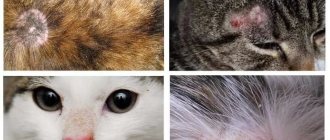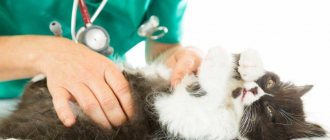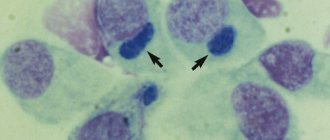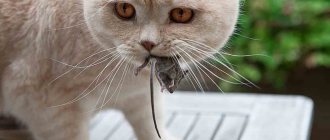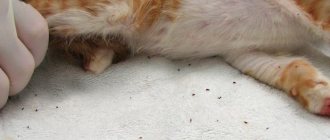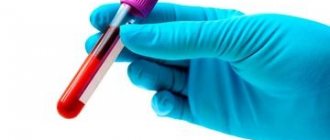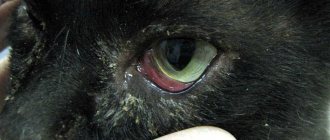27.08.2019
Skin diseases in cats
no comments
5560
Cat chin acne is a common skin condition in the feline species. To be more precise, this is the most common manifestation of acne in cats. It can appear at any age and the gender of the animal does not matter. The disease can get worse, worse, or even be extremely difficult to treat. Signs and symptoms range from barely noticeable comedones (blackheads) to severely inflamed and debilitating pustules. Some cats are not bothered at all, while for others, the pimples are very itchy and painful. Localized hair loss and skin redness are also common.
Causes of the disease
Inflammation of the sebaceous glands in cats is a skin disease called acne. Acne appears in the form of blackheads or blackheads. The most common area of occurrence is the chin and lip area.
There are various reasons why this skin disease appears, the main ones are:
- stressful situations, which result in disruption of the sebaceous glands and the production of large amounts of sebum;
- poor hygiene when licking yourself in hard-to-reach places, such as the chin;
- skin diseases;
- allergy;
- disturbances in the development of the sebaceous glands;
- weak immunity;
- fatty food;
- the porosity of the material of plastic animal feeding bowls, allowing bacteria to accumulate in the pores due to irregular washing of dishes.
Diagnosis of acne in cats
In this section, first of all, we want to encourage every concerned cat owner to visit a veterinarian. Self-diagnosis of ailments in an animal, just like diagnosing diseases in humans, can be extremely dangerous, since, without at least basic veterinary knowledge, you can confuse acne with another disease and aggravate it during treatment with drugs corresponding to another ailment.
Leave your acne diagnosis to your veterinarian.
The veterinarian, in turn, will not only diagnose the development of acne in a cat, but will also be able to determine:
- etiology of the disease;
- the presence of parasites in the affected area;
- level of sensitivity of the animal, etc.
When determining the disease of interest to us, it is very important to exclude skin lesions that have similar symptoms to it. So, for example, the same clinical picture can appear with:
- skin mite;
- fungal infection of the skin;
- cat leprosy;
- tumors of the glands that secrete sebum;
- allergic reaction to filler, food, care products;
- tumors of an epidermal nature;
- follicular diseases, etc.
Acne can be confused with skin mites
As you can see, the list is quite impressive, however, this is not all skin diseases that have manifestations similar to acne. By confusing one with the other when independently diagnosing and examining your pet, you can even provoke death.
Which breeds are more susceptible
Skin pathologies in the form of acne are common in cats of different breeds, different ages, and different genders.
Of course, at risk will be those cats who:
- tableware hygiene is not observed;
- the diet is not adjusted towards a balance of microelements, vitamins and nutrients;
- there is no control over the cleanliness of the skin, including in places that are difficult to lick.
How to treat acne in cats with non-medicinal methods?
Before we begin to describe drugs that help fight acne in cats, let's talk about ways to get rid of the disease that do not require their use. Of course, the application of these tips should be based on your thorough knowledge of the cause of the disease.
Before feeding your animal pills, try to cure it without using pharmaceuticals
Using two-phase lotions
These products are designed to remove makeup every day at home. As a rule, every woman and girl has this. The value of the desired liquid is that it has the following properties:
- eliminates excess sebum;
- disinfects;
- moisturizes.
Thus, this two-phase lotion is an ideal liquid for wiping spots on the body of cats that begin to become red or inflamed.
Grooming your cat is very important
Change of feed
As we have already said, food is one of the most important components of an animal’s health, which seriously affects its appearance. It is not necessary to allow acne to develop to determine whether a particular food meets your animal's needs. You just need to look at it carefully and understand how acceptable a particular food is for your pet.
So, signs of unsuitable food will be:
- dull and falling out hair, sometimes matted;
- oily skin;
- intensively appearing dental plaque;
- unpleasant odor from the animal's mouth;
- excess or, conversely, underweight animal;
- diarrhea or constipation;
- frequent vomiting, etc.
Dull, matted fur is a sign that the food is not suitable for your pet.
You should choose food in the following lines:
- super premium;
- holistic.
These two categories are represented by the highest quality food for animals. However, if you feed your pet natural food, make sure that:
- protein products prevailed in the diet;
- dairy products were replaced with fermented milk;
- the diet contained a minimal amount of carbohydrates in the form of boiled vegetables, herbs, etc.;
- provided that you have discovered an allergenic product, do not give in to your pet’s pleas and exclude the product from the menu.
Replacing filler in trays
All animals are different, even within one particular species. This statement is also true for cats, whose reactions to the same substance can be completely different. So, some of them are suitable for clumping mixtures for the toilet, others can defecate only in silica gel, and still others feel great in sawdust. In any case, the cat will show its attitude towards this or that filler not only by a skin reaction, but also by defecation in places not intended for this purpose.
Your cat will decide which litter to choose; most importantly, pay attention to her reaction
Replacing and washing dishes and trays
Some cats have a fairly obvious allergy to plastic. They should not be fed from dishes made of the specified material, and it is also undesirable to make a toilet for them from it.
Ceramic bowl is perfect for an allergic cat
However, it is quite easy to replace both the bowl and the tray. So, instead of the second one, an enameled Soviet square baking tray is perfect. Cheap and cheerful.
In addition, there is an urgent need for frequent washing of the containers in question in order to avoid the development of various pathogenic bacteria in it.
How to wash a cat's litter box? In a special article, we will look at the most popular means that can effectively get rid of the smell in the cat's litter box and wash away dirt.
Main symptoms
In the early phase, acne appears as black dots, which can be confused with dirt or sand in the fur. If you do not pay attention to the changes that have arisen in your pet’s appearance, then the next phase will be redness of the skin and swelling of the affected area.
The pet begins to itch, wounds with bloody discharge may appear at the site of scratching, and if the cat is not treated at the initial stage, the skin disease will progress and reach the appearance of ulcers, and in some cases, to patchy baldness.
If symptoms of itching, restlessness and skin rashes appear in your pet, you should immediately contact a veterinary clinic to have your animal examined.
Symptoms of acne in cats
This disease is primarily characterized by external symptoms, namely the manifestation of an accumulation of these skin lesions and a large number of comedones in one place.
On the one hand, sometimes acne is not even noticed because it does not cause discomfort to the cat, but this disease is fraught with danger, since at one moment the skin irregularities can turn into purulent foci overgrown with scabs.
Scratching is a sure sign of impending acne
Provided that infection with any infections is added to simple inflammation, the following types of clinical manifestations may also occur:
- severe itching in the affected area;
- local baldness;
- pain syndrome;
- swelling.
The animal’s reaction to all the symptoms listed above will be appropriate: the animal will begin to bite itself, rub against various surfaces, and nervously move around the premises. General changes in its condition are also possible, such as:
- unexpected manifestation of aggression towards family members;
- defecation in inappropriate places, for example, on upholstered furniture;
- ripping off furniture with claws;
- hard breath;
- low activity.
Before suppuration occurs, a large number of sebaceous plugs will appear on your pet’s skin.
Whatever manifestation turns out to be characteristic of your animal, an attentive owner will not be able to miss it. Various changes in your cat's appearance will also help you, for example:
- accumulation of comedones in the area of the animal’s chin and lips;
- dryness and peeling of the cat’s chin;
- small ulcers;
- bursting acne;
- scabs on certain areas of the skin;
- local hair loss;
- scratching in those places that the cat can reach;
- redness on the face in skin folds, etc.
Some animals with acne try to attract the attention of the owner by any means, because without it, unfortunately, they will not be able to cope with the disease.
Diagnostics in a veterinary clinic
Going to the clinic with your pet is mandatory, since the symptoms of acne are similar in their symptoms to such dangerous diseases as sarcoptic mange (scabies), eosinophilic (linear) granuloma, demodicosis (subcutaneous mite), dermatomycosis (ringworm). The appearance of acne can also be associated with an allergic reaction.
To make an accurate diagnosis, the clinic will take a skin scraping from your pet for analysis. The biomaterial is studied for the presence of bacteria and fungi.
The results of the analysis, if they confirm acne, will allow the doctor to prescribe the correct treatment and recommend that the animal owner eliminate possible household factors that irritate the animal’s skin or make changes to its diet.
Treatment method and prognosis
When treating cats for acne, you must:
- follow all doctor's orders;
- exclude excessively fatty foods from the diet;
- if there is a lack of vitamins, include them in the cat’s diet;
- Do not squeeze out blackheads on your cat’s skin;
- replace plastic utensils with glass, ceramic or stainless steel utensils;
- Wash animal utensils used for industrial wet or natural food at least twice a day.
When treating a cat for acne, the owner needs a patient and caring attitude towards recovery. Cat acne is not contagious to people and does not cause pain to the animal if it is not advanced and does not bother the pet with itching. In general, the prognosis for recovery is favorable.
A cat has black spots on his chin: how to treat it
Before starting treatment, make sure the cat is kept comfortable. Replace plastic feeders, drinkers, trays with ceramic ones and wash them regularly.
They stop treating them to leftovers, review their diet, and enrich it with vitamin and mineral supplements. The best option is premium dehydrated granules or higher. Prepare the affected areas for the application of medications: cut the hair.
Medication methods
Depending on the severity of the lesion, local or systemic treatment is combined. Pimples cannot be opened. You need to wait until they break through on their own.
The crusts are separated using an antiseborrheic shampoo containing the following components:
- sulfur;
- benzoyl peroxide;
- ethyl lactate;
- salicylic acid.
The resulting defects are treated with the following antimicrobial wound-healing ointments or solutions:
- Benzamycin;
- Mupirocin;
- Retinoids;
- Calendula tincture.
Zelenka or iodine, drying ointments irritate the skin, clog the openings of the sebaceous glands and have the opposite effect to the desired one.
The diet is adjusted. Table handouts are canceled and the animal is transferred to veterinary food for cats with skin diseases, for example, Hill's z/d. Recovery occurs after 14-21 days after starting treatment.
Be sure to read:
A cat has a lump under the skin on its stomach: what is it, causes and treatment, what to do if it festers
When external agents do not help, resort to the following oral or parenteral agents:
- anti-inflammatory corticosteroids;
- antibiotics;
- multivitamin restorative drugs;
- immunomodulators.
The duration of treatment with systemic drugs is determined by the veterinarian. You should not abuse medications without prior consultation with a specialist.
Folk remedies
Traditional medicine can be used in the treatment of Acne if your veterinarian does not object to their use. Active substances extracted from medicinal plants are used in the manufacture of pharmacopoeial preparations.
Adherents of traditional medicine report successful use of the following remedies:
- decoction of chamomile flowers;
- pumpkin pieces;
- infusion of yarrow.
What to do at home
Like other cat diseases, acne can be treated as prescribed by your veterinarian.
In order for the therapy to give the expected result, the owner needs to understand why the normal functioning of the sebaceous glands on the cat’s body has been disrupted. To do this, it is necessary to follow all the recommendations prescribed by the doctor and, after the course of therapy, establish control over the introduction of new foods, especially fatty ones.
It is important to remember that excess vitamins can also cause acne outbreaks. Therefore, vitamins also need to be given in doses.
It is necessary to monitor the hygiene of the dishes, and also wipe the cat’s chin after eating, which is difficult to lick on its own. You can wipe it with a cotton swab dipped in a decoction of calendula or chamomile.
Possible complications
If you do not provide qualified assistance to your cat in a timely manner and allow the formation of blood wounds after scratching acne areas, then a secondary infection may develop on the skin. Damaged skin is a gateway for infection; any fungus or bacteria will complicate the pet’s condition.
The right decision would be for the animal owner to contact the clinic at the initial signs of the disease, avoiding re-infection.


